

K-WANG


Allen Bradley 1753 Series GuardPLC 1800 Controller
Allen Bradley 1753 Series GuardPLC 1800 Controller
Core framework and scope of application of the document
The document follows the logical mainline of "security standards → hardware awareness → installation and practical operation → functional verification", covering the entire process of controller preparation to later testing. The applicable product is GuardPLC 1800 safety controller, which is a programmable electronic system (PES) with safety certification. It integrates 24 digital inputs, 8 digital outputs, 2 high-speed counters, 8 analog inputs, and 4 GuardPLC Ethernet communication interfaces. It complies with SIL 3 (IEC 61508) and PLe (ISO 13849-1 Cat.4) safety levels and is suitable for scenarios with extremely high requirements for fault tolerance and risk control, such as mechanical safety control and process safety monitoring.
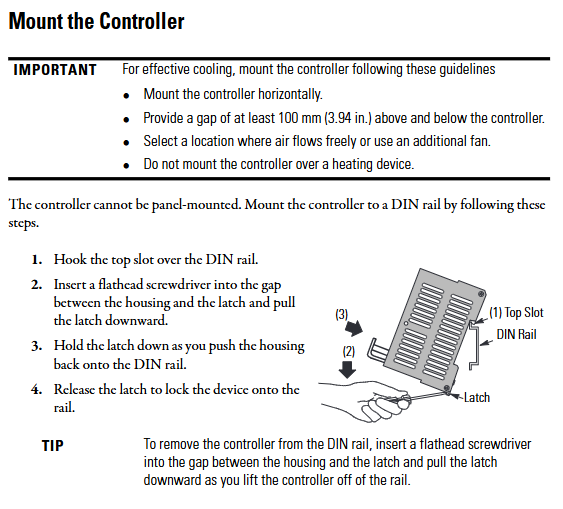
Core content sorting
(1) Controller Overview and Safety Standards
Core functions and hardware composition
Function integration: Supports the separation of secure and non secure communication. Secure communication is connected to distributed I/O, other GuardPLC controllers, or OPC servers through 4-channel 10/100BaseT RJ45 interfaces (GuardPLC Ethernet protocol); Non secure communication is achieved through 3-channel 9-pin D-shell interfaces (RS-485, etc.) to realize functions such as Modbus slave and Profibus DP slave (only 1753-L32BBBP-8A).
Hardware structure: including DIN rail installation buckle, 24V DC power interface, I/O plug-in terminal, high-speed counter interface, Ethernet interface (top 2+bottom 2), reset button (received design, anti misoperation), status indicator lights (24V DC, RUN, ERROR, PROMess, etc.). The controller is of open design and needs to be installed in a closed enclosure (protection level ≥ IP20).
Safety and Environmental Regulations
Operation qualification: It must be operated by trained professionals who are familiar with the application requirements of safety related PES (such as EN ISO 13849-1, IEC 61508).
Static electricity protection: The controller is sensitive to static electricity. When operating, it is necessary to touch a grounded object to discharge and wear a grounding wristband. It is forbidden to touch the pins or components of the circuit board. When idle, it should be stored in anti-static packaging.
Environmental requirements:
Working temperature: 0 ° C~60 ° C (32 ° F~140 ° F), storage temperature: -40 ° C~85 ° C (-40 ° F~185 ° F);
Relative humidity of 10%~95% (no condensation), pollution level 2 industrial environment, altitude ≤ 2000 meters (no need to downgrade);
It needs to be installed inside a metal casing with flame retardant properties (flame propagation level 5VA/V0, etc.), and the interior can only be accessed through tools to avoid the risk of electric shock.
(2) Installation process: from fixing to grounding
DIN rail installation (only supports DIN rail, not panel installation)
Align the guide rail: Hang the top slot of the controller on the IEC standard DIN rail (such as 199-DR1), and it is recommended to use galvanized yellow chromium steel material for the guide rail (to ensure good grounding). Fix it every 200mm (7.8 inches) and install end anchors.
Locking device: Insert a flathead screwdriver into the gap between the housing and the buckle, pull the buckle downwards, push the controller towards the guide rail, and release the buckle to complete the locking process; Reverse the operation during disassembly.
Heat dissipation requirements: Install horizontally with a minimum gap of 100mm (3.94 inches) above and below, avoiding installation above heating equipment to ensure air circulation. Install a fan if necessary.
Grounding configuration
Double grounding: The controller is functionally grounded through DIN rail, and protective grounding must be connected through a dedicated grounding screw (with grounding symbol) in the upper left corner of the housing. The grounding wire must comply with local electrical regulations (refer to Industrial Automation Wiring and Grounding Guidelines 1770-4.1).
Guide rail requirements: It is prohibited to use guide rails made of aluminum, plastic, or other materials that are prone to corrosion or have poor conductivity, in order to avoid equipment failure or safety risks caused by poor grounding.
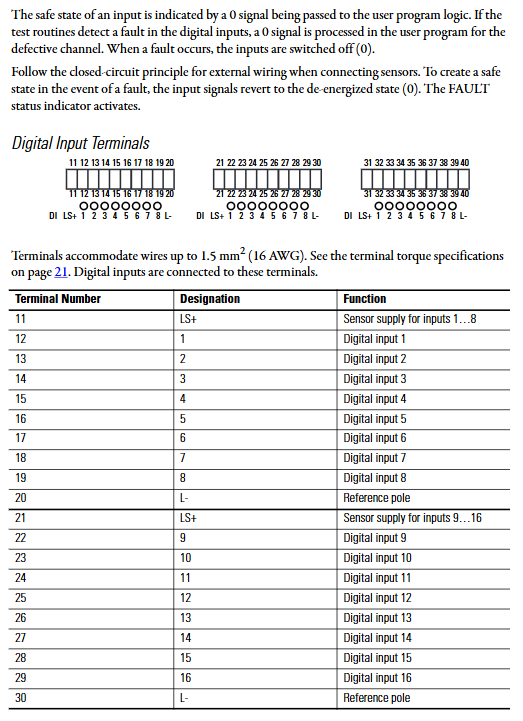
(3) Wiring Specification: Power Supply and I/O Circuit
Power wiring (24V DC)
Power requirements: An isolated power supply that complies with EN 60950/UL 1950 must be used, and it must be of the SELV (Safety Extra Low Voltage) or PELV (Protection Extra Low Voltage) level. The SELV voltage should be ≤ 30V rms/42.4V peak/60V DC, and the PELV must be connected to a protective grounding.
Wiring details: Connect the power supply through a 4-pin terminal, and ensure that L+(positive pole) and L - (negative pole) are correctly connected (without reverse polarity protection, as reversing the connection may damage the controller); The terminal supports a maximum of 2.5mm ² (14 AWG) wire and requires external 10A delay fuse protection; The L+and L - terminals are internally connected, and 24V DC Daisy chain power can be supplied to other devices through the remaining terminals.
Current characteristics: The maximum current consumption of the controller is 9A (including I/O load), and it requires 1A for its own operation. The remaining 8A can be used to power input/output devices.
Digital input wiring (24 channels, divided into 3 groups, with 8 channels per group)
Power supply and circuit: Each set of inputs is powered by an independent LS+(24V DC sensor power supply with short-circuit protection), and the input signal is referenced to L - (common terminal); Supports dry contact input or sensors with independent power supply (such as safety light curtains), and the negative pole of the external power supply needs to be connected to the controller L.
Safety design: Following the "closed circuit principle", the input signal is reset to "0" by default in case of a fault (power-off safety state); If an input fault (such as a short circuit) is detected, the input signal of the fault channel is forced to be "0", and the FAILT indicator light is activated.
Terminal specifications: The terminal supports 0.13-1.3mm ² (26-16 AWG) wires, with a tightening torque of 0.51N · m (4.5 lb · in). Terminals 11-20, 21-30, and 31-40 correspond to three sets of input LS+, input channel, and L-。
Digital output wiring (8 channels)
Load capacity:
At channels 1-3 and 5-7, the maximum current per channel is 0.5A at 60 ° C;
Channels 4 and 8 (heavy-duty channels): 1A/channel at 60 ° C, 2A/channel at 50 ° C;
The total output current is ≤ 7A, with a minimum load of 2mA per channel. When overcurrent occurs, the output is turned off and automatically restored after troubleshooting.
Wiring requirements: The output circuit should use L - (terminal 1/10) of the corresponding group as the common terminal. Even if L - is internally connected, it is still recommended to use it according to the group (EMC test verification configuration); It is recommended to parallel 1N4004 diodes to suppress interference voltage for inductive loads.
Safety feature: In the event of a fault, all outputs are forced to shut down (in a power-off safety state), and there is no monitoring of the external circuit. However, a short circuit will trigger a fault indication.
Analog input wiring (8 channels, single polarity)
Signal type:
Voltage signal: 0~10V DC (requires an external 10k Ω shunt resistor);
Current signal: 0~20mA (requires an external 500 Ω shunt resistor);
Unused analog inputs need to be short circuited (connected to I and L -) to avoid interference.
Wiring specifications: Use shielded twisted pair cables, with both ends of the shielding layer grounded, and a maximum wiring length of 300m (984 feet); Terminals 41-64 correspond to transmitter power supply (T1-T8), signal input (I1-I8), and reference terminal (L -) with 8 inputs, supporting 0.13-1.3mm ² (26-16 AWG) wires.
High speed counter wiring (2 channels, 24 bits)
Function configuration: Each counter includes three terminals: A (counting input), B (direction input), and Z (reset input). It supports 5V/24V DC signals and has a maximum input frequency of 100kHz. It can be used as a counter or a 3-digit Gray code decoder.
Wiring requirements: Use shielded twisted pair cables, with both ends of the shielding layer grounded, and a maximum wiring length of 500m (1640 feet); Terminals 65-72 correspond to A1/B1/Z1/L - and A2/B2/Z2/L - of the 2-channel counter, and unused inputs do not need to be terminated.
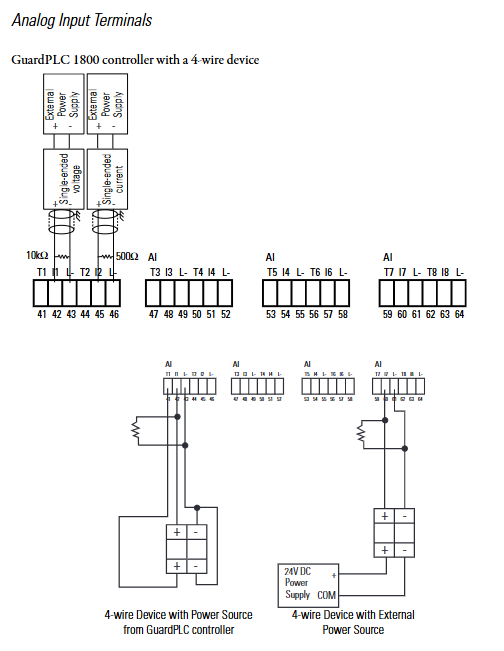
(4) Communication connection: Separation of secure and non secure
Secure Communication (GuardPLC Ethernet)
Interface configuration: 4 RJ45 interfaces (top 2+bottom 2), connected internally through an Ethernet switch, supporting automatic negotiation (full/half duplex, 10/100Mbps), can use direct or crossover Ethernet cables, supporting star/line topology (network loops are prohibited).
Application scenario: Connect distributed security I/O, other GuardPLC controllers, OPC servers (requiring 1753-OPC modules) and programming software, with MAC address attached to the bottom RJ45 interface.
Non secure communication (3-channel 9-pin D-shell interface)
Interface function:
COMM1:RS-485, Supports Modbus slave (1753-L32BBBM-8A) or Profibus DP slave (1753-L32BBBP-8A);
COMM2: Reserved (TBD);
COMM3:RS-485, Support GuardPLC ASCII protocol;
Pin definitions: Pin 3 (RxD/TxD-A) and Pin 8 (RxD/TxD-B) are for data transmission and reception, Pin 5 (DGND) is for data ground, Pin 6 (VP) is for 5V power supply, and Pin 4/9 are for control signals.
Default parameters: IP address defaults to 192.168.0.99, system ID (SRS) defaults to 60000, and custom parameters can be recorded through transparent labels (note not to obstruct ventilation holes).
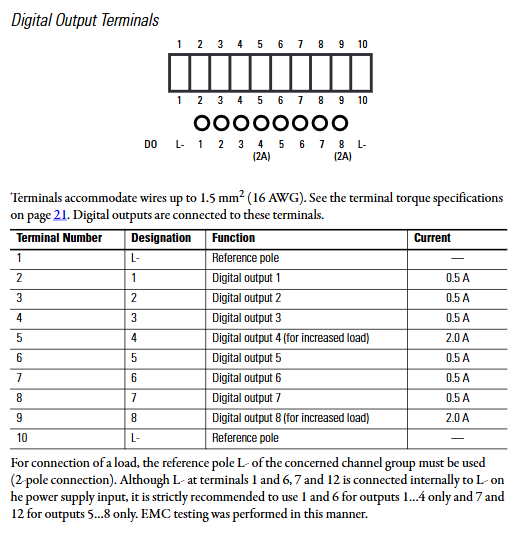
(5) Fault diagnosis and status indication
Reset button operation
Trigger scenario: When forgetting the online password for programming software and unable to obtain IP address/SRS, use an insulated needle to press the reset button (top received hole, 4-5cm from the left edge).
Reset process: Press and hold the button for 20 seconds, while restarting the controller (power off and then on). After resetting, only the default account is retained, and the IP address/SRS is restored to its default value; Restore the parameters modified before or after resetting during the next power on (depending on whether they have been modified).
Controller self-test
Power monitoring: Alarm 1 is triggered when the 24V DC voltage is below 19.3V (recording internal variables), alarm 2 is triggered when the voltage is below 15.4V (preparing to shut down), and automatic shutdown is triggered when the voltage is below 13.0V.
Temperature monitoring: A warning is triggered when the temperature is between 60 ° C and 70 ° C, a main alarm is triggered when the temperature is above 70 ° C, and the main alarm is released when the temperature drops to 64 ° C and 54 ° C (the warning is retained). When the temperature drops below 54 ° C, it returns to normal.
Interpretation of status indicator lights
|Indicator light | Status | Meaning|
|24V DC | Always on | 24V DC power supply is normal|
|| Off | No power supply or power failure|
|RUN | Always on | Running normally (executing programs, processing I/O, communication, self-test)|
|| Blinking | STOP mode (no program executed, output reset, triggered by emergency stop)|
|| OFF | VNet STOP mode (see ERROR light)|
|ERROR | Always on | Hardware failure (controller, I/O, counter), system software error, watchdog timeout (out of cycle), software restart required|
|| Off | No errors|
|PROGress | Always on | Uploading new controller configuration|
|| Blinking | Upload new operating system to non-volatile ROM|
|FAULT | Always on | Program logic error, configuration failure, operating system damage|
|| Flashing | ROM write error, I/O failure|
|OSL | Blinking | Emergency Operating System Loader Activation|
|BL | Blinking | Boot loader unable to load operating system|
|Ethernet (green/yellow) | Green constant light | Full duplex; Huang Changliang: Connection establishment|
|| Green flashing | Conflict; Yellow flashing: Interface activity|
(6) Technical specifications and certification
Core parameters
Memory: Maximum 250KB user program memory, 250KB application data memory;
Safety performance: minimum watchdog time of 10ms, minimum safety time of 20ms;
Insulation voltage: 50V DC (basic insulation) between I/O and Ethernet, Ethernet and DC power supply;
Protection level: IP20 (controller body), size 257 × 114 × 66mm (width × height × depth), weight 1.2kg.
Safety certifications: UL Listed (USA&Canada), CE (EMC Directive 2004/108/EC), C-Tick (Australia), T Ü V certification (SIL 3/IEC 61508, PLe/ISO 13849-1).
Key considerations and supplementary resources
Compliance verification: Wiring must comply with local electrical regulations (such as NEC, IEC), and safety circuit design must meet corresponding safety level requirements to avoid reducing safety performance due to improper configuration.
EMC protection: Shielded wires are required for analog inputs, high-speed counters, and Ethernet, with both ends of the shielding layer grounded; Install a filter in the power circuit to reduce the impact of electromagnetic interference on safety functions.
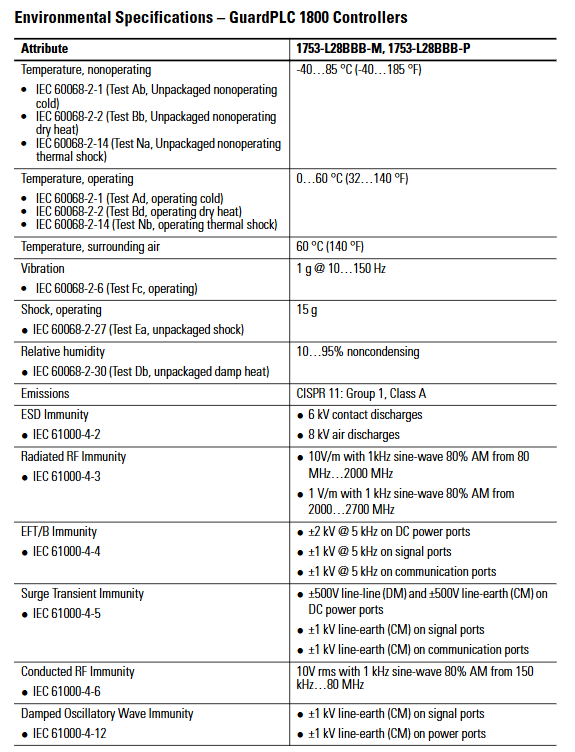
- YOKOGAWA
- Energy Access
- Renewable Integration
- Energy Subsidies
- Energy and Water
- Net zero emission
- Energy Security
- Critical Minerals
- A-B
- petroleum
- Mine scale
- Energy and Gender
- Covid-19
- man-machine
- Reliance
- ADVANCED
- SEW
- ProSoft
- WATLOW
- Kongsberg
- FANUC
- VSD
- DCS
- PLC
- Sewage treatment
- cement
- Yaskawa
- Woodward
- BOSCH Rexroth
- MOOG
- General Electric
- American NI
- Rolls-Royce
- CTI
- Honeywell
- EMERSON
- Automobile market
- xYCOM
- Motorola
- architecture
- Industrial information
- New energy
- electricity
- Construction site
- HIMA
- ABB
- Rockwell
- Schneider Modicon
- Siemens
- MAN
- GE
- TRICONEX
- Control Wave
- ALSTOM
- AMAT
- STUDER
- KONGSBERG
- MOTOROLA
- DANAHER MOTION
- Bentley
- Galil
- EATON
- MOLEX
- Triconex
- DEIF
- B&W
- ZYGO
- Aerotech
- DANFOSS
- KOLLMORGEN
- Beijer
- Endress+Hauser
- schneider
- Foxboro
- KB
- REXROTH
- YAMAHA
- Johnson
- Westinghouse
- WAGO
- TOSHIBA
- TEKTRONIX
- BENDER
- BMCM
- SMC
-
GE Hydran M2-X Enhanced Monitoring
-
ABB REG316 1mrk000809-GA Numerical Generator Protection
-
ABB RED670 1MRK004810 Line differential protection
-
GE SR750-P5-G5-S5-HI-A20-R-E Feeder protection system
-
ABB PFTL301E-1.0KN 3BSE019050R1000 PillowBlock Load cells
-
Kollmorgen S33GNNA-RNNM-00 - Brushless Servo Motor
-
Kollmorgen 6sm56-s3000-g-s3-1325 - Servo Motor
-
Kollmorgen AKM52K-CCCN2-00 - Servo Motor
-
Kollmorgen PSR3-230/75-21-202 - Power Supply
-
Kollmorgen akm24d-anc2r-00 - Servo Motor
-
Kollmorgen AKM22E-ANCNR-00 - Servo Motor
-
Kollmorgen S60300-550 - Servo Drive
-
Kollmorgen B-204-B-21 - Servomotor
-
Kollmorgen AKM21E-BNBN1-00 - Servo Motor
-
Kollmorgen TT2953-1010-B - DC Servo Motor
-
Kollmorgen pa8500 - Servo Power Supply
-
Kollmorgen BDS4A-210J-0001-207C2 - Servo Drive
-
Kollmorgen TTRB1-4234-3064-AA - DC Servo Motor
-
Kollmorgen MH-827-A-43 - Servo Motor
-
Kollmorgen AKM24D-ACBNR-OO - Servo Motor
-
Kollmorgen 00-01207-002 - Servo Disk DC Motor
-
Kollmorgen AKM21C-ANBNAB-00 - Servo Motor
-
Kollmorgen PSR3-208/50-01-003 - Power Supply
-
Kollmorgen 6SM56-S3000 - Servo Motor
-
Kollmorgen DBL3H00130-B3M-000-S40 - Servo Motor
-
Kollmorgen 6SN37L-4000 - Servo Motor
-
Kollmorgen AKM65K-ACCNR-00 - Servo motor
-
Kollmorgen 6SM56-L3000-G - Servo Motor
-
Kollmorgen AKMH43H-CCCNRE5K - Servo Motor
-
Kollmorgen PSR4/52858300 - Power Supply
-
Kollmorgen KBM-79H03-E03 - Direct Drive Rotary Motor
-
Kollmorgen AKM33E-ANCNDA00 - Servo Motor
-
Kollmorgen U9M4/9FA4T/M23 - ServoDisc DC Motor
-
Kollmorgen AKM13C-ANCNR-00 - Servo Motor
-
Kollmorgen AKM43L-ACD2CA00 - Servo Motor
-
Kollmorgen AKM54K-CCCN2-00 - Servo Motor
-
Kollmorgen M-605-B-B1-B3 - Servo Motor
-
Kollmorgen AKD-P00606-NBAN-0000 - Rotary Drive
-
Kollmorgen 6SM-37M-6.000 - Servo Motor
-
Kollmorgen A.F.031.5 - Sercos Interface Board
-
Kollmorgen 918974 5054 - Servo PWM
-
Kollmorgen U12M4 - ServoDisc DC Motor
-
Kollmorgen AKD-B00606-NBAN-0000 - Servo Drive
-
Kollmorgen MV65WKS-CE310/22PB - Servo Drive
-
Kollmorgen 65WKS-CE310/22PB - Servo Drive
-
Kollmorgen EM10-27 - Module
-
Kollmorgen S64001 - Servo Drive
-
Kollmorgen CR03200-000000 - Servo Drive
-
Kollmorgen 6SM57M-3000+G - Servo Motor
-
Kollmorgen BDS4 - Servo Drive
-
Kollmorgen AKD-P00306-NBEC-000 - Servo Drive
-
Kollmorgen AKD-B01206-NBAN-0000 - Servo Drive
-
Kollmorgen STP-57D301 - Stepper Motor
-
Kollmorgen 6SM37L-4.000 - Servo Motor
-
Kollmorgen 44-10193-001 - Circuit Board
-
Kollmorgen PRDR9SP24SHA-12 - Board
-
Kollmorgen PRD-AMPE25EA-00 - Servo Drive
-
Kollmorgen DBL3N00130-0R2-000-S40 - Servo Motor
-
Kollmorgen S406BA-SE - Servo Drive
-
Kollmorgen AKD-P00607-NBEI-0000 - Servo Drive
-
Kollmorgen AKD-P01207-NBEC-0000 - Servo Drive
-
Kollmorgen CR03550 - Servo Drive
-
Kollmorgen VSA24-0012/1804J-20-042E - Servo Drive
-
Kollmorgen N2-AKM23D-B2C-10L-5B-4-MF1-FT1E-C0 - Actuator
-
Kollmorgen 04S-M60/12-PB - Servo Drive
-
Kollmorgen H33NLHP-LNW-NS50 - Stepper Motor
-
Kollmorgen A-78771 - Interlock Board
-
Kollmorgen AKM43E-SSSSS-06 - Servo Motor
-
Kollmorgen AKD-P00607-NBEC-0000 - Servo Drive
-
Kollmorgen E21NCHT-LNN-NS-00 - Stepper Motor
-
Kollmorgen cr10704 - Servo Drive
-
Kollmorgen d101a-93-1215-001 - Motor
-
Kollmorgen BDS4A-203J-0001-EB202B21P - Servo Drive
-
Kollmorgen MCSS23-6432-002 - Connector
-
Kollmorgen AKD-P01207-NACC-D065 - Servo Drive
-
Kollmorgen CK-S200-IP-AC-TB - I/O Adapter and Connector
-
Kollmorgen CR10260 - Servo Drive
-
Kollmorgen EC3-AKM42G-C2R-70-04A-200-MP2-FC2-C0 - Actuator
-
Kollmorgen BDS5A-206-01010-205B2-030 - Servo Drive
-
Kollmorgen s2350-vts - Servo Drive
-
Kollmorgen AKM24D-ANC2DB-00 - Servo Motor
-
Kollmorgen E31NCHT-LNN-NS-01 - Stepper Motor
-
Kollmorgen PRD-0051AMPF-Y0 - Servo Board
-
Kollmorgen TB03500 - Module
-
Kollmorgen 60WKS-M240/06-PB - Servo Drive
-
Kollmorgen M21NRXC-LNN-NS-00 - Stepper Motor
-
Kollmorgen H-344H-0212 - Servo Motor
-
Kollmorgen MCSS08-3232-001 - Connector
-
Kollmorgen AKM33H-ANCNC-00 - Servo Motor
-
Kollmorgen PA-2800 - Power Supply
-
Kollmorgen MTC308C1-R1C1 - Servo Motor
-
Kollmorgen PRDR0091300Z-00 - Capacitor Board
-
Kollmorgen BDS4A-206J-0024/01502D79 - Servo Drive
-
Kollmorgen S20330-VTS - Servo Drive
-
Kollmorgen S20250-CNS - Servo Drive
-
Kollmorgen SBD2-20-1105-WO - Servo Drive Board
-
Kollmorgen M405-C-A1--E1 - Servo Motor
-
Kollmorgen PRD-PB805EDD-00 - Servo Drive
-
Kollmorgen 6SM57S-3.000-J-09-HA-IN - Servo Motor
-
Kollmorgen AKM33H-ANCNDA-00 - Servo Motor
-
Kollmorgen PCB-00030200-04 - PCB
-
Kollmorgen H22SSLB-LNN-NS-02 - Stepper Motor
-
Kollmorgen BJRL-20012-110001 - Module
-
Kollmorgen BDS4A-206J-0001404A - Servo Drive
-
Kollmorgen H-342-H-0802 - Servo Motor
-
Kollmorgen CR10561 - Servo Drive
-
Kollmorgen BDS5A-206-00010-205B2-030 - Servo Drive
-
Kollmorgen BDS5A-206-00010-207B-2-030 - Servo Drive
-
Kollmorgen mcss08-3224-001 - Connector
-
Kollmorgen M-207-B-23-B3 - Servo Motor
-
Kollmorgen PRD-0041200Z-S0 - Encoder/Resolver Card
-
Kollmorgen MH-225-G-61 - Motor
-
Kollmorgen MT308B1-T1C1 - Servo Motor
-
Kollmorgen BDS4A-240J-0001604C83 - Servo Drive
-
Kollmorgen 6SM57-S-3000 - Servo Motor
-
Kollmorgen N-T31V-15-5B-6-MF3-FT1E-C251 - Actuator
-
Kollmorgen PRD-0051AMPA-X0 - Servo Board
-
Kollmorgen CF-SS-RHGE-09 - Cable
-
Kollmorgen DIGIFAS7204 - Servo Drive
-
Kollmorgen S30101-NA - Servo Drive
-
Kollmorgen DIGIFAS7201 - Servo Drive
-
Kollmorgen PRD-0051AMPA-Y0 - Servo Board
-
Kollmorgen AKM23D-EFCNC-00 - Servo Motor
-
Kollmorgen SE10000 - Servo Drive
-
Kollmorgen PSR4/5A-112-0400 - Power Supply
-
Kollmorgen AKM31H-ANCNC-01 - Servo Motor
-
Kollmorgen M-203-B-93-027 - Servo Motor
-
Kollmorgen CP-SS-G1HE-05 - Connector




